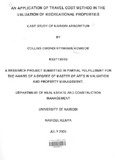An application of travel cost method in the valuation of recreational properties case study of Nairobi arboretum

View/
Date
2005Author
Kowuor, Collins Omondi Nyangwe
Type
ThesisLanguage
enMetadata
Show full item recordAbstract
This research is aimed at not only enlightening the readers on the need to assign
monetary values to natural resources particularly recreation sites but also to compare
suitability of various models.
Recreation sites are important to any population especially the urban population. New
recreation sites need to be provided while existing ones are conserved and expanded to
meet the needs of the ever growing urban population.
Travel cost method is suitable for valuation of recreation sites and its premise is that the
total cost incurred in visiting a recreation site is the 'price' paid for buying the product.
The number of visits to a site is determined by the total cost incurred in accessing it
hence the demand function.
Travel cost has various variations such as individual travel cost model and zonal travel
cost model which employs different approaches in analysis of travel cost. They are
suitable under different circumstances as they result in different valuation outcomes. It is
therefore important to use the model which gives the most optimal recreation value to
enable it compete effectively with other uses.
The recreational values calculated using the two models was compared with what the
market would offer for the next best alternative use. The next best alternative is . .
residential since the case study falls under zone 4. The optimal value equals or greater
than market based appraised value. The comparison revealed that individual travel cost
model resulted in a comparatively more optimal recreational valuation.
Citation
Master of arts in valuation and property managementPublisher
Department of real estate and construction management
